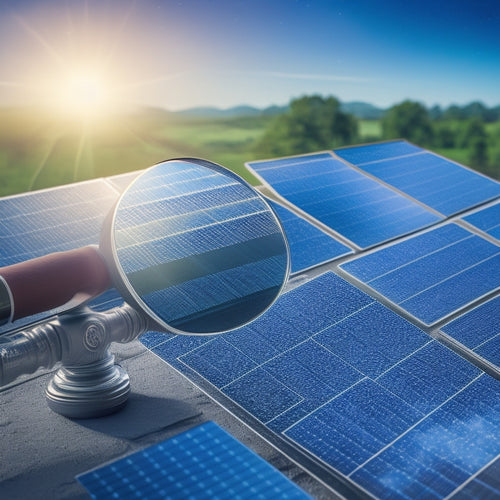What Are the 7 Key Factors Affecting Roof Solar System Cost
Share
When determining the cost of a roof solar system, you'll need to take into account seven key factors. Your roof's size and complexity, including its orientation and shading, play a significant role in the overall expense. The type and quality of panels, as well as the inverter's efficiency and brand, will also impact your costs. Additionally, the mounting and racking systems, permits and installation costs, and local incentives and rebates all factor in. Finally, customization and installation considerations, such as energy production and customization, can further affect your system's cost. As you weigh these factors, you'll get a clearer illustration of what to expect for your roof's unique needs.
Key Takeaways
- Roof size and complexity significantly impact system cost, with larger roofs requiring more panels and complex designs increasing labor costs.
- Roof orientation and shading affect system performance, with ideal orientation between south and west, and shading analysis identifying energy output obstructions.
- Type and quality of solar panels influence energy output, with higher efficiency panels being more costly and durable panels requiring less maintenance.
- Inverter efficiency and brand impact energy conversion, with higher efficiency inverters providing long-term savings and reputable brands ensuring installation quality.
- Customization complexity, permits, and local incentives also affect system cost, with customized designs increasing labor and material costs, and incentives enhancing return on investment.
Roof Size and Complexity
Typically, a larger roof translates to a higher solar system cost. This is because a bigger roof requires more solar panels to generate the same amount of electricity, which increases the overall cost. Additionally, a larger roof may require additional mounting hardware, wiring, and labor, further driving up costs.
However, it's not just the size of your roof that matters - its design and complexity also play a significant role. A roof with multiple levels, skylights, or unusual angles can make installation more challenging, increasing labor costs and the risk of complications.
Installation accessibility is also an essential factor, as difficult-to-reach areas may require specialized equipment or additional labor, adding to the overall expense. When evaluating your roof's suitability for solar, consider its design and complexity to get an accurate estimate of the installation costs.
Type and Quality of Panels
When selecting solar panels for your roof, you'll need to take into account the type and quality of the panels, which greatly impact the overall cost of the system.
You'll want to evaluate panel efficiency ratings, which affect how much energy your system can produce, as well as durability and warranty, which influence the system's lifespan and maintenance needs.
Panel Efficiency Ratings
The type and quality of solar panels you choose greatly impact the overall cost of your roof solar system. When selecting panels, you'll come across various efficiency ratings, which greatly influence your system's energy output.
Panel efficiency ratings, measured in percentages, indicate how well a panel converts sunlight into electricity. Higher efficiency ratings translate to more energy produced per unit area, which can be beneficial if you have limited roof space.
For instance, a 20% efficient panel will produce more energy than a 15% efficient panel of the same size. However, high-efficiency panels typically come at a higher cost.
You'll need to weigh the benefits of increased panel performance against the added expense. When evaluating panel efficiency, consider your energy goals, available roof space, and budget.
Durability and Warranty
Several key factors influence the durability and warranty of your roof solar system, and the type and quality of panels you choose play a significant role.
The durability of your solar panels directly affects their longevity expectations, which in turn impact the overall cost of your roof solar system. High-quality panels made with durable materials can withstand harsh weather conditions and last longer, reducing the need for frequent replacements and maintenance.
When evaluating the durability of your solar panels, look for manufacturers that offer extensive warranty coverage. A good warranty should cover the panels' performance, materials, and workmanship for an extended period, typically 25 years or more.
A longer warranty period indicates the manufacturer's confidence in their product's quality and longevity. Be sure to review the warranty terms and conditions carefully to understand what's covered and what's not.
Inverter Efficiency and Brand
You're likely aware that your roof solar system's inverter plays a critical role in converting DC power from your solar panels into usable AC power for your home.
When it comes to inverter efficiency and brand, you have options. You can choose from different inverter types, such as string inverters, microinverters, or power optimizers, each with their own efficiency ratings and brand reputation.
Efficiency ratings vary between brands, with some offering up to 99% efficiency. A higher efficiency rating means more energy is converted and less is wasted.
Additionally, brands with a strong reputation often have higher installation standards, resulting in a more reliable system. Maintenance requirements also vary, with some brands offering remote monitoring and troubleshooting.
When comparing costs, consider not only the upfront price but also the warranty options and potential long-term savings. For example, a more efficient inverter may cost more initially but provide greater energy output over its lifespan.
Mounting and Racking Systems
When you're evaluating mounting and racking systems for your roof solar installation, you'll need to take into account the type of system you need, as tracking systems or adjustable tilt systems can be more expensive than fixed-tilt systems.
The quality of the materials used in the system also impacts cost, with high-quality materials like anodized aluminum or stainless steel being more expensive than lower-quality options.
Additionally, customization requirements, such as unique roof layouts or obstructions, can increase the complexity and cost of the system.
System Type Variations
Your roof's solar system cost heavily depends on the type of mounting and racking system you choose. The two primary categories are fixed-tilt and tracking systems. Fixed-tilt systems are the most common, offering a cost-effective solution with a standard installation angle.
On the other hand, tracking systems are more complex, allowing the solar panels to adjust their angle to maximize energy production throughout the day. This increased system performance comes at a higher cost.
When it comes to installation techniques, you'll need to decide between rail-based and rail-less systems. Rail-based systems involve attaching the solar panels to a rail, which is then secured to your roof.
Rail-less systems, also known as "clamping" systems, directly attach the panels to your roof without the need for rails. While rail-less systems can be more expensive, they offer a sleeker appearance and can be more suitable for certain roof types.
Ultimately, the choice of system type variation will depend on your specific needs, budget, and roof characteristics. By understanding the pros and cons of each option, you can make an informed decision that balances system performance with cost.
Material Quality Impact
The quality of materials used in mounting and racking systems greatly affects the overall cost of your roof solar system. You'll find that high-quality materials, such as anodized aluminum or stainless steel, are more expensive than lower-quality options like galvanized steel. However, they provide better durability and resistance to corrosion, ensuring your system lasts longer and performs more efficiently.
Material sourcing also plays a significant role in determining the cost of your mounting and racking system. Locally sourced materials tend to be cheaper than those imported from other countries, which may be subject to tariffs and transportation costs.
Additionally, the complexity of the installation techniques used can impact the overall cost. For instance, a system that requires specialized installation tools or equipment will be more expensive than one that uses standard tools and methods.
When choosing a mounting and racking system, it's crucial to evaluate the trade-offs between material quality, material sourcing, and installation techniques. While high-quality materials may be more expensive upfront, they can provide long-term savings through reduced maintenance and replacement costs.
Customization Complexity Costs
Designing a customized mounting and racking system to accommodate unique roof features or layouts increases the complexity of the installation, driving up costs.
You'll need to take into account factors like installation flexibility, aesthetic considerations, and technology integration to guarantee a seamless fit with your existing roof structure. A custom design allows you to enhance energy production based on your specific energy needs, but it also requires more planning, engineering, and labor, resulting in higher costs.
When opting for a customized mounting and racking system, you'll need to factor in future scalability as well.
Will you need to expand your solar system in the future? If so, a custom design can accommodate this, but it will add to the upfront cost. Additionally, advanced system monitoring capabilities may be required to guarantee maximum performance, which can further increase costs.
It's crucial to weigh the benefits of a customized mounting and racking system against the added expense to determine if it's the right choice for your roof solar system.
Permits and Installation Costs
Local authorities and regulatory bodies require homeowners to obtain permits before installing a roof solar system, and these permits come at a cost.
You'll need to factor in the cost of obtaining these permits, which can vary depending on your location and the type of solar system you're installing. Permit requirements can include electrical, building, and zoning permits, among others.
The installation timeline also plays a significant role in determining the overall cost of your roof solar system.
You'll need to take into account the labor costs associated with the installation process, which can be affected by the complexity of the installation, the size of the system, and the installation company's rates. A longer installation timeline can lead to higher labor costs, so it's crucial to work with an installer who can complete the job efficiently.
Additionally, you may need to pay for inspections and testing to verify the system meets local building codes and safety standards.
Roof Orientation and Shading
Optimize your roof solar system's energy output by considering its orientation and shading. The ideal roof orientation for solar panels is between south and west, as this allows for maximum solar exposure throughout the day.
However, if your roof isn't oriented in this direction, don't worry - installation techniques can be adjusted to compensate.
A shading analysis is essential to identify any obstructions that might affect your system's performance. This includes trees, buildings, and even roof features like vents or skylights.
- Consider the following factors that impact your roof's solar potential:
- Roof pitch: Steeper roofs can be more difficult to install on, but may provide better solar exposure
- Seasonal variations: Leaves on trees may block sunlight during certain times of the year
- Maintenance considerations: Cleaning panels regularly can improve energy output
- Aesthetic impact: The appearance of your solar system can affect your home's curb appeal
Local Incentives and Rebates
With solar energy becoming increasingly cost-competitive, governments and utilities are offering attractive incentives and rebates to encourage homeowners like you to invest in roof solar systems.
These incentives can greatly reduce the upfront cost of your solar system, making it more affordable and increasing your return on investment.
As a homeowner, you're eligible for federal tax credits, which can cover up to 26% of your solar system's total cost.
Additionally, local utility rebates can provide further discounts, sometimes up to $1,000 or more, depending on your location and utility provider.
These incentives can add up quickly, making your solar system more affordable and increasing your savings over time.
To take advantage of these incentives, research the specific programs available in your area.
Check with your local government and utility provider to see what rebates and credits you're eligible for.
Frequently Asked Questions
Can I Install a Solar System on a Metal or Clay Tile Roof?
You can install a solar system on a metal or clay tile roof, but you'll need to guarantee proper metal roof installation and clay tile compatibility to avoid damage and guarantee a secure, watertight seal.
How Long Does a Typical Solar Panel Installation Take?
Like a conductor leading an orchestra, you'll want to synchronize your solar panel installation timeline with expert precision. Typically, it takes 3-5 days for a residential installation, depending on system size and installation efficiency, ensuring a harmonious shift to renewable energy.
Are Solar Systems Resistant to Extreme Weather Conditions?
You'll be glad to know that solar systems are designed to withstand extreme weather conditions, featuring solar panel durability that guarantees performance even in harsh environments, and extreme weather resilience that assures your system remains operational and efficient.
Can I Add More Panels to My Existing Solar System Later?
You can expand your existing solar system by adding more panels, but you'll need to evaluate cost factors and guarantee panel compatibility to maintain efficiency and avoid potential technical issues.
Do Solar Systems Require Regular Maintenance or Repairs?
You'll want to budget for occasional solar maintenance, like cleaning and inspecting your panels, to guarantee peak performance. While rare, repair costs can arise, but they're typically minimal, and many manufacturers offer warranties to cover unexpected issues.
Conclusion
As you wrap up your solar roof system research, remember that the cost can vary wildly - it's like trying to nail a million moving pieces together! But by understanding the 7 key factors, you'll be well-equipped to maneuver through the process. From roof size and complexity to local incentives and rebates, each element plays a vital role in determining the final price tag. By considering these factors, you'll be able to find a system that's customized to your needs and budget.
Related Posts
-

Solar Panel System Certification Costs: A 10-Point Breakdown
You're looking to understand the costs associated with solar panel system certification. Your total certification cos...
-

5 Ways Bike Sharing Boosts Urban Sustainability
As you explore bike-sharing options, you'll discover five ways it boosts urban sustainability. By reducing congestion...
-

What Are the Average Cost Savings of Solar Panels
You can expect to save between $400 and $1,000 per year on your electricity bills with solar panels, which translates...


